
Meliaceae, the mahogany family, is a flowering plant family of mostly trees and shrubs in the order Sapindales.

The chivi vireo is a small South American songbird in the family Vireonidae. It was formerly considered a subspecies of the red-eyed vireo. It is usually green to yellow-green in color with off-white underparts, and a gray crown. It has a whitish supercilium extending over its ear coverts, and its lores are dull gray in color. The chivi vireo has nine subspecies. It is found throughout most of northern, eastern and central South America, only being absent from southern Chile and southern Argentina. It inhabits multiple types of habitat across its range, and appears to adjust well to slightly disturbed habitat. The chivi vireo is mainly resident, but at least two of the subspecies inhabiting the south of its range are known to be migratory.
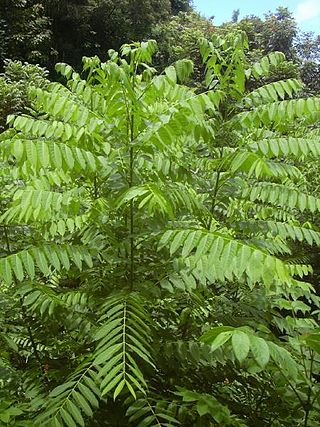
Cedrela is a genus of several species in the mahogany family, Meliaceae. They are evergreen or dry-season deciduous trees with pinnate leaves, native to the tropical and subtropical New World, from southern Mexico south to northern Argentina.

Azadirachta is a genus of two species of trees in the mahogany family Meliaceae. Numerous species have been proposed for the genus but only two are currently recognized, Azadirachta excelsa and the economically important tree Azadirachta indica, the neem tree, from which neem oil is extracted. Both species are native to the Indomalaysian region, and A. indica is also widely cultivated and naturalized outside its native range.

Guarea is a genus of evergreen trees or shrubs in the family Meliaceae, native to tropical Africa and Central and South America. At their largest, they are large trees 20–45 m tall, with a trunk over 1 m diameter, often buttressed at the base. The leaves are pinnate, with 4–6 pairs of leaflets, the terminal leaflet present. They are dioecious, with male and female flowers on separate plants. The flowers are produced in loose inflorescences, each flower small, with 4–5 yellowish petals. The fruit is a four or five-valved capsule, containing several seeds, each surrounded by a yellow-orange fleshy aril; the seeds are dispersed by hornbills and monkeys which eat the aril.

Pouteria is a genus of flowering trees in the gutta-percha family, Sapotaceae. The genus is widespread throughout the tropical Americas, with outlier species in Cameroon and Malesia. It includes the canistel, the mamey sapote, and the lucuma. Commonly, this genus is known as pouteria trees, or in some cases, eggfruits.
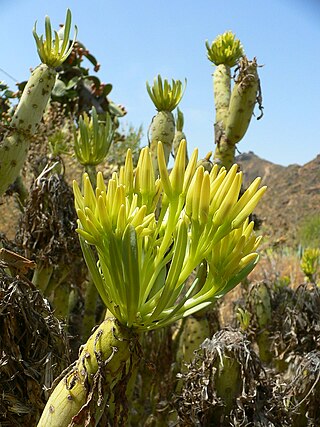
Kleinia is a genus of flowering plants in the sunflower family. Kleinia contains around 50 species and is distributed from Morocco and the Canary Islands, throughout Sub-Saharan Africa, the Arabian Peninsula, South Asia and Indochina. It is closely related to the genus Senecio but is distinguished primarily by having succulent stems or leaves.

Aglaia lawii is a species of tree in the family Meliaceae. As well as the autonym species, there are two subspecies accepted.

Schmardaea is a genus of trees in the family Meliaceae. It solely comprises the species Schmardaea microphylla.
Trichilia trachyantha is a species of flowering plant in the family Meliaceae. It is endemic to Cuba.
Turraeanthus is a genus of plants in the family Meliaceae. They are dioecious trees or treelets, with pinnate leaves. It contains the following species:
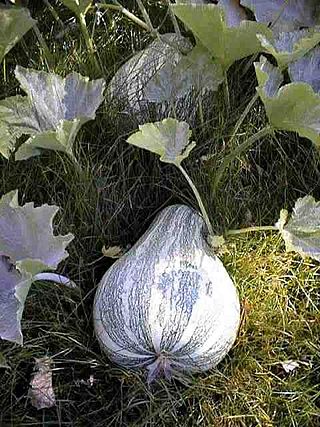
Cucurbita argyrosperma, also called the cushaw squash and silver-seed gourd, is a species of winter squash originally from the south of Mexico. This annual herbaceous plant is cultivated in the Americas for its nutritional value: its flowers, shoots, and fruits are all harvested, but it is cultivated most of all for its seeds, which are used for sauces. It was formerly known as Cucurbita mixta.

Chisocheton is a genus of trees in the family Meliaceae. The genus name comes from the Greek schizos and chiton meaning "split tunic", referring to the lobed staminal tube of C. patens. Their range is from India and tropical China, throughout Malesia and south to New South Wales and Vanuatu.

Chisocheton cumingianus is a tree in the family Meliaceae. The tree is named for the English naturalist Hugh Cuming. Habitat is rain forests from sea-level to 1,300 metres (4,300 ft) elevation. C. cumingianus is found from India and tropical China through Indochina and throughout Malaysia. In the Philippines, the seeds of C. cumingianus are used to make a non-drying oil either for traditional medicine or as fuel for oil lamps.
Didymocheton mollissimus is a species of tree in the family Meliaceae. It ranges from eastern India and Bangladesh to southern China, Myanmar, Thailand, Peninsular Malaysia, Borneo, Sumatra, Java, the Lesser Sunda Islands, and the Philippines, where it grows in lowland tropical moist forests.
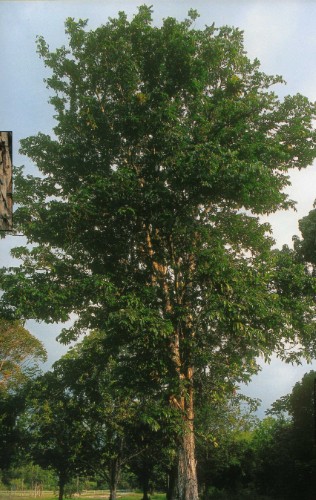
Carapa guianensis is a species of tree in the family Meliaceae, also known by the common names andiroba or crabwood.
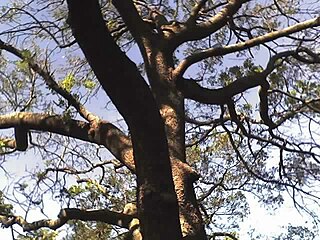
Ekebergia is a genus of flowering plants belonging to the family Meliaceae. They are dioecious trees or shrubs, with odd-pinnate leaves.
Guarea hoffmanniana is a species of flowering plant in the family Meliaceae. It occurs in Costa Rica and Panama.
Dysoxylum acutangulum is a species of flowering plant in the mahogany family, Meliaceae. It is a tree native to Peninsular Thailand, Malesia, New Guinea and the Solomon Islands, and the Northern Territory and Queensland in Australia.













